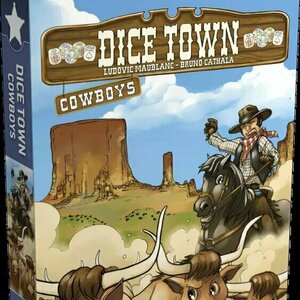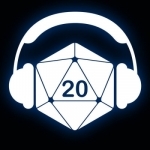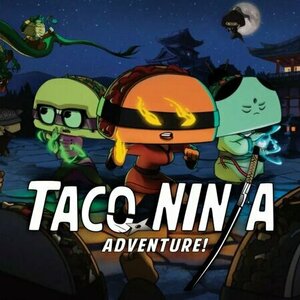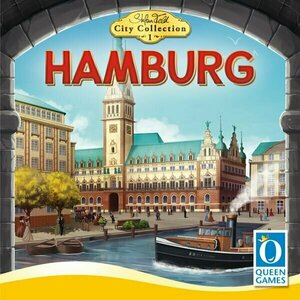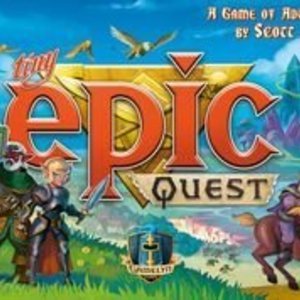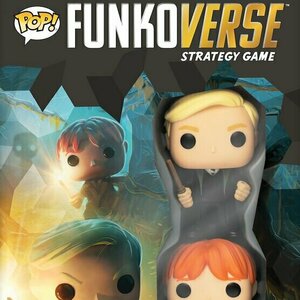
Funkoverse Strategy Game: Harry Potter 101
Tabletop Game
In the Funkoverse Strategy Game, you combine your favorite characters and go head-to-head in four...
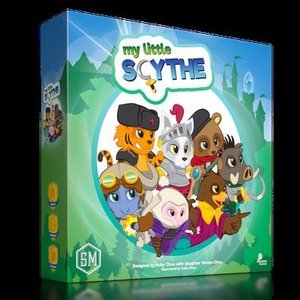
My Little Scythe
Tabletop Game
My Little Scythe is a competitive, family-friendly game in which each player controls 2 animal...
PrintNPlayGames Boardgames 2017Games
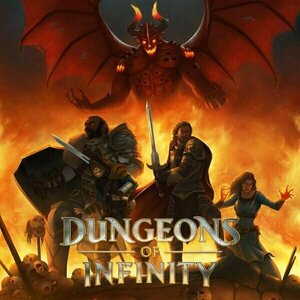
Dungeons of Infinity
Tabletop Game
Explore an unknown dungeon with up to 5 Heroes. The dungeon is created randomly as you explore....
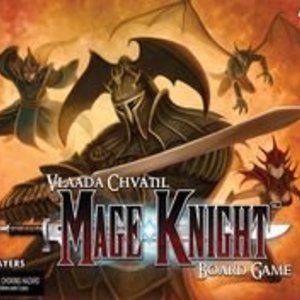
Mage Knight Board Game
Tabletop Game
The Mage Knight board game puts you in control of one of four powerful Mage Knights as you explore...
Boardgames RPGgames
Purple Phoenix Games (2266 KP) rated Dice Town: Cowboys in Tabletop Games
Jun 25, 2021
This breakdown is for the push-your-luck dice and take-that game Dice Town’s expansion Cowboys.
This expansion adds a new board overlay to placed between Town Hall and Doc Badluck, 21 cow minis, some General Store cards to be shuffled with the base game, 12 Cowboy card, and four Rodeo cards. The Rodeo cards are 10 VP cards that are earned once a player owns a Cowboy card in each suit. Cowboy cards are recruited by the player who rolls the most Aces. They have the choice of recruiting a Cowboy or Stealing Cows (first from the new Prairie Board overlay, but if empty, then from other players). Cowboy cards can offer various abilities to be used or can be saved to earn a Rodeo VP card. Cow minis can be kept in a loose herd in front of the player or can be added on top of a Deed card in order to keep the Deed card and cows from being stolen by other players. If a Deed card shows, for example, a value of 4 then four cows will need to be added to the Deed card. Once the Deed card has its herd of cows upon it, the card is now worth an extra VP. Also at game end the player with the largest herd of cows will earn 10 additional bonus VP. Yee haw!
So here’s the thing: I love Dice Town as is. But adding in this expansion just adds another layer of strategic complexity and increases the enjoyment for me by tons. Having little cows in my play area and using them to graze upon my land deeds is quite satisfying. Being able to sprinkle in some of the Cowboy cards and hopefully earn a Rodeo card as well just boosts the ol’ final score by a significant amount. So the addition of this expansion is all about those VP gainz.
Official recommendation: I think any gamer who owns and enjoys Dice Town should definitely pick up the Cowboys expansion. It adds very important components to the base game and offers more choices for great rolls. And what gamer doesn’t appreciate more choices? This is a definite must-buy for me, but I wouldn’t turn down a chance to play just the base game either.

On Tour
Tabletop Game
You’re living the dream. You’re in a band and they’re about to go on tour. It’s your job to...
Boardgames 2018Games MusicGames
Purple Phoenix Games (2266 KP) rated Taco Ninja Adventure in Tabletop Games
Feb 15, 2021
Taco Ninja Adventure is a card battling game for two to six players where each player will control at least one Taco Ninja. It’s a taco head with a bipedal humanoid body. And they know ninjutsu. These ninjas duke it out on the battlefield to display the greatest technical skills and the Taco Ninja team that can deliver the final bite to the opponents will be the winner.
DISCLAIMER: We were provided a copy of this game for the purposes of this review. This is a retail copy of the game, so what you see in these photos is exactly what would be received in your box. I do not intend to cover every single rule included in the rulebook, but will describe the overall game flow and major rule set so that our readers may get a sense of how the game plays. For more in depth rules, you may purchase a copy online or from your FLGS. -T
To setup each team (in my case I played two player so we each controlled two Taco Ninjas) will choose their Taco Ninjas in alternating fashion and begin the game in the Battlefield (near each other on the table). The Item and Attack card decks are to be shuffled and the first three Attack card revealed to create a market row. Each player draws two Item cards to be kept secret from the opposing team and a life tracker with the cube on 30 HP. The death battle may now begin!
On a turn the player will decide whether they would like to stay on the Battlefield to fight or retreat to the Dojo to retool. If they remain on the Battlefield the active Taco Ninja will choose an opponent also on the Battlefield to target. Three Yahtzee-style dice rolls later the attacking Taco Ninja will either deliver damage to the opponent, heal themselves, or draw an Item card to be used on a later turn. Each of these results are compared against a reference card that shows successful attacks for 3 of a Kind, 4 of a Kind, Full House, and 5 of a Kind for maximum damage. Rolling two pairs yields an Item card and either 4 or 5 in a row yields healing to the active Taco Ninja.
Should the Taco Ninja wish to retreat to the Dojo they may instead draw either an Item card, one of the face-up Attack cards, or an Attack card blindly from the top of the deck. Item cards can be played on the owner’s turn or out of turn in some cases. Attack cards usually will add damage to successful attacks if its specific dice roll requirement is met.
Once a Taco Ninja is knocked out from sustaining too much damage they are sent to the Afterlife. While a Taco Ninja exists in the Afterlife they will still take turns rolling. They can roll certain results to heal their teammate still on Earth or even reincarnate if the correct result is rolled.
When one team has sent both of their Taco Ninjas to the Afterlife they are finished and the winning team may devour their remains. If these are actually cannibalistic anthropomorphic tacos.
Components. This game is mostly cards with a few cubes, five dice, and a cloth drawstring bag. The cards are all fine, the cubes of normal quality and brown and orange in color, and the dice are the small dice (maybe 12mm?). The art style throughout is obviously cartoony tacos, so it invokes a feeling of silliness that I appreciate. I do not really know what the bag is for other than to protect the cubes and dice in the box? In the rules it mentions a first-player marker, which I found none of in the box, so I used the bag as that marker. It’s a nice bag. No problems with the components from me.
I do have a slight grumble with the name of the game, however. This is a head-to-head card and dice-based deathmatch. Unfortunately the Taco Ninjas do not actually go out adventuring, just battling and dying. So I think a more apropos title could have been Taco Ninja Crunchfest or On Eating Taco Ninjas. That’s ridiculous and I am sorry for making you read this paragraph.
All in all the game is actually quite a good time. It is very light and simple to learn, but strategizing attacks and when to retreat to grab more Item and Attack cards is great. Yes, at the end of the day all turns are decided by dice rolls, so no amount of strategy should logically work fully, but it is still fun to just roll dice and demolish some tacos in the process. Please do not expect anything more than a nice little filler game here. A game night probably will not revolve around Taco Ninja Adventure, but perhaps several games using different characters or a round-robin tournament could be enjoyable.
That said, Purple Phoenix Games gives this one a delicious 8 / 12. It is highly portable, very light, appetizingly fun, and has a unique theme. If you are looking for a good solid filler game that is a bit different in style and theme than most, I would have you take a look at Taco Ninja Adventure. It might just be the cardboard antipasto you have been seeking.
Purple Phoenix Games (2266 KP) rated Tiny Epic Quest in Tabletop Games
Jul 29, 2019 (Updated Jul 9, 2020)
A world at peace has been thrust into chaos once more as mysterious portals have opened across the lands, spewing forth treacherous Goblins! The citizens need heroes – and that is your specialty! Traverse the lands to fight Goblins, learn magic spells, and delve into ancient temples to find powerful artifacts to aid in your battle for good.
Disclaimer: I do not intend to rehash the entire rulebook in this review, but give a general overview of the rules and the gameplay. If you want to read the rules more specifically, pick up a copy of the game at your FLGS or directly from the publisher. – L
Tiny Epic Quest is a game of area movement, dice rolling, and push your luck, in which players are trying to amass the most end-game victory points. How do you earn VPs? By completing quests, fighting Goblins, and learning spells! A game of Tiny Epic Quest is played over 5 rounds, and each round is broken into 2 phases – the Day Phase and the Night Phase. The Day Phase consists of 4 turns where you will can move your heroes. A turn plays out like this: the starting player selects one of the 5 available movement cards and moves 1 hero according to those restrictions. Following clockwise, each other player may move 1 hero in the same manner, or choose to Idle and not move. Once everyone has moved or idled, the next turn starts and play continues as before. After 4 movement cards have been performed, the Day Phase ends.
Moving on to the Night Phase, players have the opportunity to perform the actions associated with the card regions onto which they moved during the Day Phase. If you moved to a Goblin Portal, for example, you now have the chance to fight. On your turn in the Night Phase, you will roll the Adventure Dice and resolve them in an attempt to complete your goals – defeating goblins, completing temples, or learning spells. Quests can be completed in either the Day or Night Phase, depending on the requirements. When you complete a quest, collect the card and hang onto it for end-game scoring. The Night Phase ends when all players have opted to Rest (either by choice or by becoming exhausted), and the round is over. Perform the round resolutions (refill goblin portals, etc.), and then continue on to the next round. After 5 rounds, tally up your VPs, and the player with the most is the winner!
For such a ‘tiny’ game, Tiny Epic Quest definitely has a lot going on. The amount of strategy required for this game is pretty intense. You not only have to decide where to move your heroes, you also have to think about what you want to do and how you want to earn your VPs. Do you want to take a combative approach and try to kill as many goblins as possible? Do you want to try your luck at learning high-level spells? Or is your strategy dictated by the current quest cards in play? Not only do you have to figure out your own strategy, you are also trying to figure out how your opponents are playing as well. Will you try to beat them to a temple first or will you let them do their own thing as long as they don’t interfere with your plans? There is no single right way to play this game, and that’s what makes it so engaging and fun with every play.
That being said, this game also has a fair amount of push your luck in the form of the Adventure Dice. Not all of the die faces are beneficial to you, and they are resolved in a specific order. Damage always is dealt to you first, and if you take too much damage, you immediately become exhausted. When that happens, all of your heroes are returned to your starting castle, and any progress you had made on goblin fights, temple tracks, or spell-learning is lost. You really have to be thinking about how far you are willing to go, and if it is worth one more roll of the dice to risk success or complete failure.
Tiny Epic Quest is kind of a double-edged sword for me. I enjoy games that require decent strategy, but I also am not too fond of push your luck games. This game can sometimes feel like it’s working against you – all of your strategic setup in the Day Phase could be undone with some unfortunate dice rolls in the Night Phase. No matter how solid your strategy is, the dice will ultimately seal your fate. Don’t get me wrong, part of the fun of Tiny Epic Quest is figuring out how to bounce back after a poor Night Phase. But dice can be brutal sometimes and that can take away from your enjoyment.
So where does Tiny Epic Quest fit into the family? I would say it’s a cousin that you like, but don’t see too often. I enjoy playing this game from time to time, but it is definitely not my go-to Tiny Epic game. The rulebook could use some simplification, and for being a Tiny Epic game, it is kind of a table hog. Some of the strategy for me is negated by the dice-rolling mechanic, but it could also be because I am a notoriously bad dice roller… Would I recommend Tiny Epic Quest? Ultimately, yes I would. I may not personally like some of the aspects of play, but the game itself is engaging and entertaining. If you haven’t checked this one out yet, give it a shot! Purple Phoenix Games gives Tiny Epic Quest a valiant 9 / 12.
